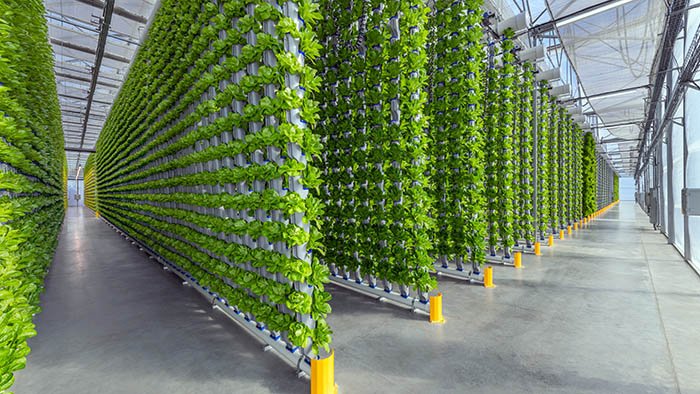(Depiction of the vertical farming method – Eden Green)
Vertical farming has always been considered a futuristic concept. However, it has emerged as a viable transformative way for a better future agriculture. By growing the usual crops, but in vertically stacked layers and in controlled indoor environments, the method solves critical challenges such as resource scarcity, climate change, and urbanization. Global populations are growing, and traditional farming methods are facing challenges now more than ever. Vertical farming on the other hand, is not only sustainable, but meets food demands and has minimal environmental impact.
What is vertical farming?
Vertical farming is a method which involves cultivating crops in vertical layers in indoor environments, usually in urban areas. It uses soilless techniques like hydroponics, aeroponics, and aquaponics. Unlike traditional farming, vertical farming doesn’t rely on horizontal land use and maximizes space by stacking growing systems (Dupois, 2024). This method also allows year-round production, with no effect whatsoever in weather or seasonal changes and conditions.
What are the benefits of vertical farming?
Firstly, a big advantage of vertical farming is water and land efficiency. It reduces both water and land use, in contrast to the traditional farming method we have used for centuries. These systems use up a staggering 99% less land and 98% less water by recirculating water in hydroponic setups. For instance, a vertical farm can produce about 240 times as much crops on the same land area (USDA ARS, 2025).
Second of all, vertical farming maintains a constant year-round production. Indoor environments can control not only temperature, but humidity and light, allowing the crops to grow at a consistent pace regardless of the external conditions (Bowery, 2023). This eliminates seasonal limitations, and provides a steady supply of fresh produce.
In addition, vertical farming has a reduced environmental impact. By minimizing the pesticide use and chemical overuse, vertical farming protects the ecosystem and reduces work. A 2024 study found that vertical farming requires 28 times less land than other traditional methods, which frees up space for other agricultural and even ecological use (Wikipedia, 2025).
Finally, this revolutionizing method ensures urban integration. These farms can be built in cities, which reduces the transportation costs and the carbon footprint this long-distance transportation produces. This proximity to clients or citizens also shortens the food waste by making the supply chain shorter.
What are the environmental trade-offs?
As a matter of fact, there are issues with vertical farming, since if there weren’t, it would have already been implemented. First of all, vertical farming involves an enormous amount of energy consumption, mostly for the artificial lighting and the climate control systems. Up to 40% of a vertical farm’s environmental impact comes from electricity use. Still, switching to renewable energy sources can reduce the emissions, making the vertical farming’s carbon footprint and that of the traditional methods the same.
In addition, other trade-offs include higher freshwater eutrophication and acidification potentials compared with conventional farming.
However, new technologies and innovations in the materials used could efficiently minimize these issues.
Challenges and Limitations:
An apparent limitation that has been previously mentioned is the high energy and initial costs. Basically, vertical farming requires a lot of investment in infrastructure, technology, and skilled specialized labor. Energy-intensive systems, like LED lighting, contribute to the costs unless powered by renewable energy.
Another crucial challenge to consider are the crop limitations. Most vertical farms have a bigger focus on greens and herbs due to their accelerated growth and low space use. Also, crops usually need pollination, creating even more challenges without natural pollinators and suggesting that it will require more labor.
Finally, scalability also remains a crucial limiting factor to the success of this method. While vertical farming succeeds in urban areas, scaling to meet the current global food demand is still a difficult barrier. Traditional crops like corn or wheat are not suited for this type of farming, which limits their role in food production.
The future of agriculture:
The potential of vertical farming aligns with urban environments and sustainability goals. Yet, due to its limitations and challenges, it has only been implemented in a certain number of continents across the globe, including Asia, North America, Europe, and the Middle East. Not surprisingly, neither Africa and Oceania nor South America have successfully implemented vertical farming, largely due to a lack of resources, especially financial ones. However, as technology constantly improves and advances, this method could become the base of modern agriculture. Renewable energy integration and innovation is improving every day, which proves how close this revolutionary method really is. For example, replacing all the UK’s lettuce fields with vertical farming could save 20,000 acres of land.
However, vertical farming is still unlikely to replace traditional agriculture entirely. It could fill its role as a complement to the existing systems by addressing multiple needs, like that for fresh produce in urban environments. As a matter of fact, government collaboration, with the help of farmers and research, will facilitate the implementation of this futuristic system, as it still has a lot of barriers to overcome until unlocking its full revolutionary potential.
Conclusion:
Vertical farming symbolizes a step towards sustainable food production. It stands as a solution to land scarcity, water consumption, and harsh climate conditions. While there are still multiple crucial challenges, its ability to be implemented in urban areas and its reduced environmental footprints stand as fundamental components to the future of agriculture. As the world continues to struggle with feeding a growing population, vertical farming stands as a step to innovation and a revolutionary method to world-wide sustainability.
Works Cited:
“Vertical Farming – No Longer a Futuristic Concept.” Vertical Farming – No Longer A Futuristic Concept : USDA ARS, Agricultural Research Service, www.ars.usda.gov/oc/utm/vertical-farming-no-longer-a-futuristic-concept/#:~:text=JA%3A%20Traditional%20farming%20involves%20planting,other%20methods%20of%20soilless%20agriculture. Accessed 4 Mar. 2025.
Farming, Bowery. “Vertical Farming: Why Growing up Can Make a Difference.” Bowery, 2 May 2023, bowery.co/vertical-farming/.
Dupuis, Allison. “Vertical Farming: Everything You Need to Know.” Eden Green, Eden Green, 21 Nov. 2024, www.edengreen.com/blog-collection/what-is-vertical-farming.
“Vertical Farming.” Wikipedia, Wikimedia Foundation, 4 Feb. 2025, en.wikipedia.org/wiki/Vertical_farming.

